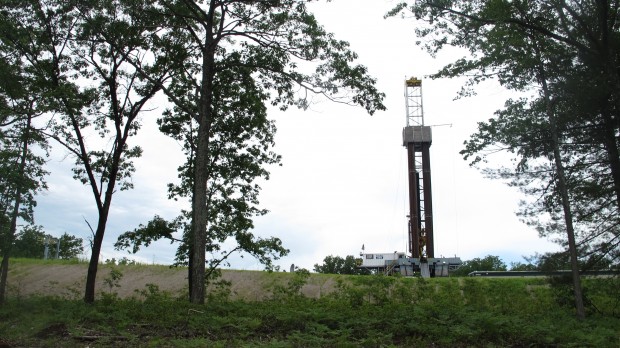EIA projects higher natural gas prices and production in 2017

Marie Cusick / StateImpact Pennsylvania
Natural gas production from rigs like this is expected to rise in 2017 in response to increasing prices, the U.S. Energy Information Administration said.
U.S. natural gas prices are expected to rise in 2017 on growing domestic consumption, increased pipeline exports to Mexico, and more exports of liquefied natural gas, the U.S. Energy Information Administration said in its Short-Term Energy Outlook Tuesday.
The agency, part of the federal Department of Energy, predicted the spot price of natural gas will rise to an average of $3.12 per million BTUs next year, up from an average of $2.50 in 2016.
Residential retail prices, measured in dollars per thousand cubic feet, are expected to decline from $10.68 this month to $9.63 in February before recovering toward the middle of 2017.
Natural gas production for 2016 as a whole is expected to post its first decline since 2005 but is due to start a rebound in 2017 in response to more drilling and as more pipelines are built, the EIA said.
“EIA expects production to start rising in November as a result of increases in drilling activity and infrastructure buildout that connects natural gas production to demand centers,” the report said.
It predicted that natural gas production will rise by 2.9 billion cubic feet a day (bcf/d) in 2017 from its level in 2016, when it declined by 1.4 bcf/d from 2015.
In Pennsylvania, the second-biggest gas-producing state after Texas, the projected national price increase will prompt more drilling and more activation of wells that have already been drilled but have not been producing gas because of low prices and a shortage of pipelines, said John Quigley, former Secretary of Pennsylvania’s Department of Environmental Protection.
“Production from Pennsylvania will continue to increase at a significant rate,” Quigley said. “The uptick in prices absolutely will translate into more drilling.”
Quigley, now a senior fellow at the University of Pennsylvania’s Kleinman Center for Energy Policy, said that around 30 percent of Marcellus Shale wells are not in active use because of the low-price environment that has existed since 2009.
Even with the anticipated spot price gain next year, the average will still be less than half its pre-recession level of $8.89 in 2008, according to EIA data.
Despite the large number of inactive wells – some of which will be brought online – there will also be an increase in the number of rigs drilling new wells, in response to a price increase, Quigley said. “The typical response when prices rise is, regardless of a backlog, we’re going to see an increase in drilling activity.
“Prices have been at historic lows, they don’t have any place to go but up,” he said. “From a directional perspective, I would completely agree that prices are bound to go up.”
Still, any price rise will be limited by the expected increase in production, Quigley said. “It’s in the nature of the resource extraction play. Companies create a glut, then they slow down, and then prices rebound, demand catches up and they repeat the same pattern.”
Nationally, the anticipated rise in natural gas prices is expected to narrow the gap between the share of electricity generated by natural gas and that by coal, the EIA said. Utility-scale power generation from natural gas is expected to drop to 33 percent in 2017 from 34 percent this year, while that from coal will increase to 31 percent from 30 percent.
















